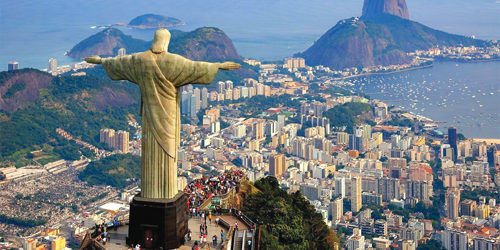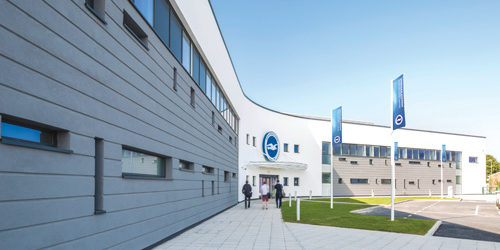
There is so much noise. The boxy sound systems blast heavy waves of it into the air, each one emitting a different anthem ranging from samba music to power ballads. I’m wandering through a warren of multicoloured homes stacked upon one another like Lego cubes in the favela of Vila Canoas, one of Rio’s “ghettos”. Ricardo, my guide, explains that for the inhabitants living here in the densely occupied favela, aside from their passion for music, playing loud tunes is a way of having some privacy from neighbours, especially when they want to make love. And, quite often, when they want to make it seem like they are.
On this warm Saturday afternoon, children chase each other through tight alleyways and over graffitied steps, while a jolly group of men are well into a large bottle of deep red wine. We then explore Rocinha, Rio’s largest favela. Swarms of thick, black electricity cables criss cross above me, where people have pilfered power from the mains. I’m surprised to encounter a sushi bar and even a ballet school. We stop for a cup of icy, indigo-coloured acai dessert, topped off with hundreds and thousands and peanuts. I’m struck by the vibrancy, and the fun, benign atmosphere of somewhere I had anticipated being much more downtrodden.
“People in the favelas are really happy,” says Ricardo. “But now, all the governmental money that was supposed to be helping the favelas and getting poor people in education is being cut.” Soon after Rio won the Olympic bid in 2009, an $8 billion government initiative was launched called Morar Carioca. It promised to upgrade each of Rio de Janeiro’s favelas within the following decade, by improving sanitation systems and transport networks; installing water drainage systems, street lighting, road surfacing; and creating green and recreational spaces. All in all, the idea was to change the lives of the people who call them home — roughly a fifth of Rio’s entire population.
Morar Carioca was meant to be integral to the social legacy of the Olympic Games. Unfortunately, over time, the project was dismantled gradually, and Morar Carioca has been described as the “greatest unfulfilled promise” in Rio de Janeiro.
There was an encouraging start, with police seizing back control of Rio’s favelas from drug gangs and traffickers. However, during the run-up to the Games, the programme lost its place on the political agenda, and the favelas returned to being largely ignored. Ricardo reports a worrying resurgence of crime to the favelas, and at one point, while Ricardo and I are driving, we hear a sinister boom echoing from a favela across the valley that can only have been made by a grenade. “The gangsters understand that these pacifying policies are dismantling, and they are occupying the favelas again,” Ricardo says.
The other Olympic promises for Rio are yet to be fulfilled. There are plans to convert Rio’s Future Arena into four schools for the Rio neighbourhoods of Barra, Jacarepagua and Sao Cristovao – the stadium’s roof, panels, poles and even it’s plumbing will be dismantled, transported to these neighbourhoods and re-assembled into schools. And the aquatic stadium will be repurposed to form two public swimming pools. Unlike Beijing’s ‘Bird’s Nest’ stadium, which generates around $11 million in maintenance costs annually while standing mostly unused, at least Rio’s plans for its Olympic infrastructure are centred around sustainability.
The Barra Olympic Park will be converted into public parks and private development; it was initially hoped that, as with Queen Elizabeth Olympic Park in London, the space would be used to tackle Rio’s housing crisis.
Around seven million more housing units are needed — to the point where even inhabitants in Rocinha favela are paying around $1,000 per month to live there, according to Ricardo. The controversy surrounding the Olympic Park is well documented. The favela of Vila Autodrome was demolished in order to build the 4,200 sqm park, which led to the resettlement of some 350 families into purpose-built complexes — most of whom fought hard to save their homes. Now that the Olympics is over, the 31 skyscrapers of the Athletes’ Village will indeed be converted into housing.
However, instead of providing accommodation for the area’s original residents, these towers will become luxury residences, completing developer Carlos Carvalho’s vision of transforming Barra into “a city of the elite, of good taste.” Driving through Barra in October, I see the cranes stationed all over the place, ready to build and welcome Barra’s “new crowd”.
It’s easy to be pessimistic, without acknowledging that some aspects of Rio’s Olympic plans were well-intentioned, but perhaps dashed by a crippling recession and volatile political climate. Following a period of strong economic growth, the BRIC nation was hit hard by the fall in oil prices (black gold accounts for more than 30% of its GDP) and today, its state-owned energy corporation,
Petrobras is currently battling to save its reputation after allegations of corruption. Times have been tough, but despite this, Brazil’s business potential remains strong. The Brazilian real became the best performing currency this year, increasing 23% since January. The country’s growing middle class presents plenty of opportunity for overseas investors, and certain industries — particularly the motor, aviation, and oil drilling sectors — retain their key place on the world stage.
According to the latest reports, it’s anticipated that Brazil will be one of the beneficiaries of Trump’s presidency, as trade ties with Mexico will potentially be diminished, and investors look for other markets with natural resources (every cloud…).
Finally, the Ministry of Tourism in Brazil reports that the number of international events taking place in Brazil has increased by a whopping 400% over the past decade, meaning its assets are being showcased to more foreign business professionals than ever before. Rio de Janeiro’s lure as a city is undeniable, and, as a first time visitor to the city, it was everything I hoped it would be — full of warmth, beauty, honesty and fun.
“We have this seductive culture,” says Ricardo. “Everywhere in Rio, you sense how easy going it is. You can go to a place where you don’t know anyone and in ten minutes, someone’s bought you a beer. It’s just so alive.” Whether you’re soaking up the glamour of Ipanema and Copacabana Beaches, swaying in a samba club in Lapa, or sipping the “best caipirinha in the solar system” from a plastic cup in Vila Canoas, it’s only a matter of time before you fall under Rio’s spell.
Top Four Event Spaces
BELMOND COPACABANA PALACE
This landmark Rio hotel stands proudly across from Copacabana beach, and its elegant Golden Room is the venue of choice for well-heeled weddings. There’s an atmospheric wood-panelled library for meetings, while the restored 1920s casino makes for a special event for 1,200 people. belmond.com
GRAND HYATT RIO DE JANEIRO
Opened in time for the Olympics, this five-star hotel is situated in Barra de Tijuca, 45 minutes from Copacabana. The hotel has 1,850 sqm of conference space, including sleek boardrooms with views of Marapendi Lagoon, and a team of warm, dedicated staff. riodejaneiro.grandhyatt.com
M GALLERY SANTA TERESA HOTEL
A stone’s throw from the artist galleries and bohemian bars of the hilltop Santa Teresa district, this upscale boutique hotel has an inviting pool terrace with incredible city views. sofitel.com
MAMA SHELTER RIO DE JANEIRO
Opened last month, Rio’s outpost of the boutique Mama Shelter brand is also located in Santa Teresa. Littered with modern, quirky decor and social areas, it has meeting space for 20 people and a lush terrace. mamashelter.com
Where to Eat and Drink
Zazas
Occupying a pretty blue ‘casa’ in Ipanema, this characterful bistro offers organic Brazilian fare. Choose an upstairs seat so you can take off your shoes, recline around a low table and admire the fairy-world-inspired ceiling. zazabistro.com
Fogo de Chao Botafago
Tuck into succulent meat sliced directly onto your plate at this sophisticated churrascaria steakhouse with twinkling lake views. Prepare to be stuffed. fogodechao.com.br
Scenarium
Party long into the night at this multi-floor nightclub, where you can peer over a balcony on the second floor to watch the samba dancers and band below. A word of warning: you don’t pay for drinks until you leave, which can make you throw caution to the wind… rioscenarium.art.br
Fasano Hotel
The rooftop pool bar of this luxury Philippe Starck-designed hotel in Ipanema is the perfect place to grab a cocktail and watch the sky turn pink as the sun sets over the iconic Hill Brothers rocks. fasano.com.br






